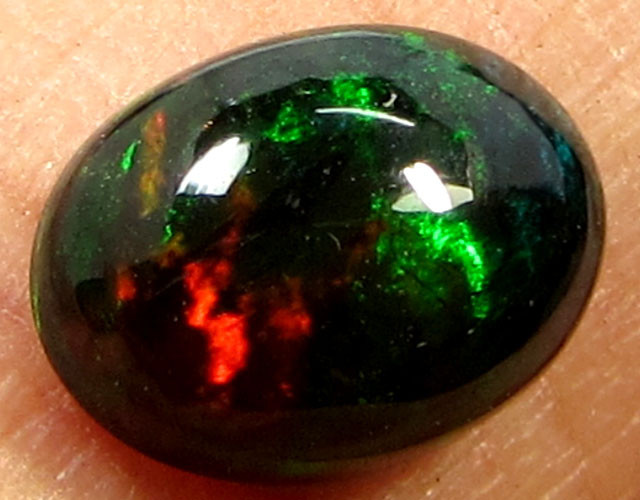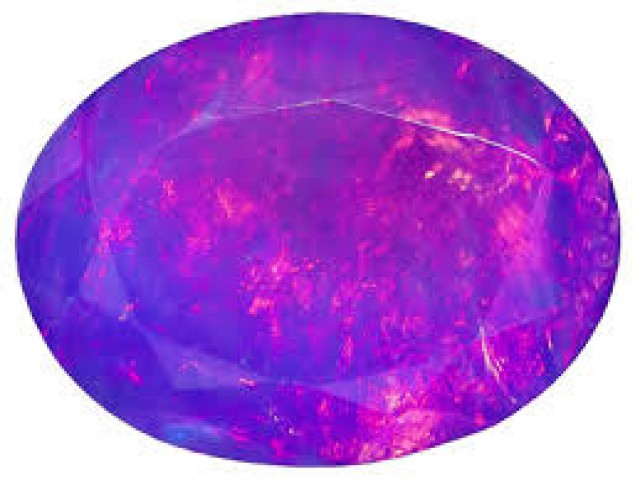
Objavljeno 9th May 2018
Izmijenjeno 17th Nov 2025
Ocjenjivanje i uzorci etiopskih opala
 Etiopski opal jedna je od najraznolikijih i najspektakularnijih vrsta opala na današnjem tržištu. Budući da je ova vrsta opala nova, ne postoji industrijski prihvaćen način ocjenjivanja ove vrste opala kao što je to slučaj s crnim opalom. Crni opal se ocjenjuje prema crnini, svjetlini boje i uzorku.
Etiopski opal jedna je od najraznolikijih i najspektakularnijih vrsta opala na današnjem tržištu. Budući da je ova vrsta opala nova, ne postoji industrijski prihvaćen način ocjenjivanja ove vrste opala kao što je to slučaj s crnim opalom. Crni opal se ocjenjuje prema crnini, svjetlini boje i uzorku.
Slično tome, etiopski opal se također ocjenjuje prema uzorku i svjetlini, ali ton tijela kamena ne igra veliku ulogu u određivanju konačne vrijednosti.
Etiopski opali imaju mnogo jedinstvenih uzoraka, a na Opal Auctions opisi moraju biti točni. Jedan od najpopularnijih uzoraka na etiopskim opalima je prirodno oblikovana linija u obliku saća s inkluzijama mreže poznata kao uzorak saća. Ovaj uzorak je vrlo rijedak kod bilo koje druge vrste opala. Ovi oblici saća ponekad imaju i svjetliju ili drugačiju boju od okolnog opala, što je također rijetka pojava u prirodi.
Boja i svjetlina etiopskog Welo opala
Ovo se odnosi na vatru unutar opala. Prozirna unutarnja vatra ovih etiopskih opala ima svojstva koja vatri daju trodimenzionalni izgled. Ovaj trodimenzionalni aspekt boje rijedak je kod većine opala. Izgleda kao da je vatra zarobljena unutar opala.

Mnogi australski crni opali imaju skrivene uzorke spektra boja duboko unutar opala, tako da plavi opal može imati skrivene prozirne pruge boja s ljubičastim ili ljubičastim nijansama koje se ne mogu izravno vidjeti golim okom. Etiopski opali imaju žive prozirne pruge boja i uzorke koji su izrazito svijetli i vidljivi golim okom.
Etiopski opali se cijene na temelju svojih jarkih bljeskova vatrene boje. Što je boja svjetlija i intenzivnija, to je cijena opala viša. Kamenje s crvenim bljeskovima rjeđe je od ostalih boja, dok su zeleni i plavi bljeskovi češći.
Obrađeni etiopski crni opal
Bio sam na nedavnom sajmu dragulja u Bangkoku gdje sam vidio velike količine etiopskog crnog opala koji se prodaje, a izvješća o draguljima tvrde da je prirodan. Nova otkrića pokazala su da većina, ako ne i sav, "crni" etiopski opal koji se sada vidi na tržištu nije ono što se čini! Ili se obrađuje inovativnim novim tehnikama "dimljenja" kako bi se dobio izgled crnog opala. Budući da je ovaj opal hidrofan, čini se da dobro reagira na dimljenje. Tehnike dimljenja nisu nove kada je u pitanju opal, ali ono što se sada koristi na etiopskom opalu uvodi novi zaokret staroj metodi dimljenja, zbog čega su cijenjeni laboratoriji za ispitivanje dragulja propustili taj tretman.

Stara tehnika se koristila na opalu niske kvalitete, poput meksičkog hidrofana, kako bi se potamnila boja osnovnog materijala, što je - nasuprot tome - uzrokovalo vatreniju igru boja. To se radilo jednostavnim čvrstim omatanjem opala u smeđi papir, stavljanjem u pokrivenu posudu, zagrijavanjem na srednjoj vatri dok papir potpuno ne izgori, a zatim hlađenjem i pranjem. Rezultat je bio puno ljepši opal!
Drugi tretman koji je uobičajen s etiopskim opalom je promjena boje kamena bojom. Neki kameni mogu imati jarko ružičastu ili ljubičastu boju koja je umjetno unesena u kamen.

Ovo je zasad jedini poznati tretman za etiopski opal i uvelike smanjuje cijenu kamena. Na Opal Auctions svi tretmani moraju biti jasno navedeni. Ako imate bilo kakvih nedoumica, ne zaboravite koristiti našu uslugu Opal Sheriff kako biste dobili drugo mišljenje.
Jedino što još treba biti svjestan je lažni etiopski opal koji je danas na tržištu. Pročitajte naš članak o otkrivanju lažnih opala kako biste se naoružali znanjem potrebnim za ispravnu identifikaciju lažnih etiopskih opala.
Uzorak u etiopskom opalu
Etiopski opal ima širok raspon prekrasnih uzoraka i oblika, od ovalnih do slobodnih. Crni opali iz Australije dobro su dokumentirani s jedinstvenim uzorcima, od skuše do harlekina. Slična imena usvojena su za opis etiopskih opala. Najtraženiji i najskuplji uzorak je uzorak saća meda.
Široki uzorak kristala

Patchwork Rolling Flash

Saće od patchworka

Šesterokutna saćasta ili riblja ljuska

Pin Fire Crystal

Uzorak neonskog bljeska

Welo Broad Flash

Uzorak duge

Široki patchwork

Višestruki vatromet

Široki bljesak požara

Cvjetni uzorak očiju

Vatreni oblak

Welo Patchwork Harlequin uzorak
Harlekin se smatra najrjeđim uzorkom u industriji opala, a Etiopija ima svoj jedinstveni uzorak - uzorak saća. Uzorak saća je najrjeđi uzorak na etiopskom opalu s kabošonom. Mnogi rudari opala nikada neće pronaći jedan od ovih uzoraka u svom radnom vijeku.
Pravi harlekin uzorak je mozaik širokog uzorka, kutno gustog skupa boja. Cvjetni uzorci se ponekad nazivaju cvjetni harlekin, ali Welo Floral ili Welo patchwork bi bio ispravan naziv za ove etiopske opale s cvjetnim uzorkom.

Kupujte etiopske opale
Pretražite Opal Encyclopedia
Povezane aukcije
povezani članci
Boulder Opal je jedan od najpotcijenjenijih opala na tržištu. Saznajte više o ovom jedinstvenom opalu i pregledajte prekrasno kamenje koje imamo na prodaju.
29th May 2019
Wayne i Estella Sedawie, strastveni ljubitelji opala, osnovali su Opal Plus prije više od 14 godina i otkrili da je internet vrijedan alat. Upravo se tamo odvija većina međunarodnih transakcija tvrtke.
17th Oct 2018
Najnoviji članci
Otkrijte kako se opali ocjenjuju i koji čimbenici utječu na njihovu cijenu. Od boje i svjetline do brušenja i podrijetla, saznajte kako se svaka vrsta opala procjenjuje - s primjerima cjenovnih raspona.
19th Jul 2023
Krenite na putovanje i saznajte više o ljekovitoj moći opala od naše gostujuće spisateljice Vivien Schapere iz Crystal Healing Techniques!
20th May 2023
Opal Kraljice Plamena (ili Vatreni) najskuplji je opal na svijetu, koji se prodaje za moderni ekvivalent od 3 milijuna dolara. Saznajte sve o njegovoj povijesti i kvalitetama!
18th Feb 2023
Kategorije članaka
All there is to know about Opals including Black Opals, Ethiopian Opals & Boulder Opal
14 Članci
Check out our fascinating information and articles on all things amazing in the Opal world
41 Članci
Opal Auctions sellers who are approved as opal Verified Sellers
4 Članci









